Evaluating Tourism Development and Planning in the Philippines
VerifiedAdded on 2023/04/10
|15
|3960
|77
Report
AI Summary
This report provides a comprehensive analysis of sustainable tourism development in the Philippines. It examines the benefits to stakeholders from proper planning, advantages and disadvantages of public and private sector partnerships, and features of tourism development planning at different levels. The significance of interactive planning systems, methods for measuring tourist impact, and approaches to resolving conflicts of interest are also evaluated. Furthermore, the report analyzes the implications of balancing supply and demand, addresses moral and ethical issues, compares tourism development issues in emerging and developed countries, and offers recommendations for the development of the tourism industry in the Philippines. The report emphasizes the importance of sustainable practices for economic growth, community integration, and resource management within the Philippine tourism sector.
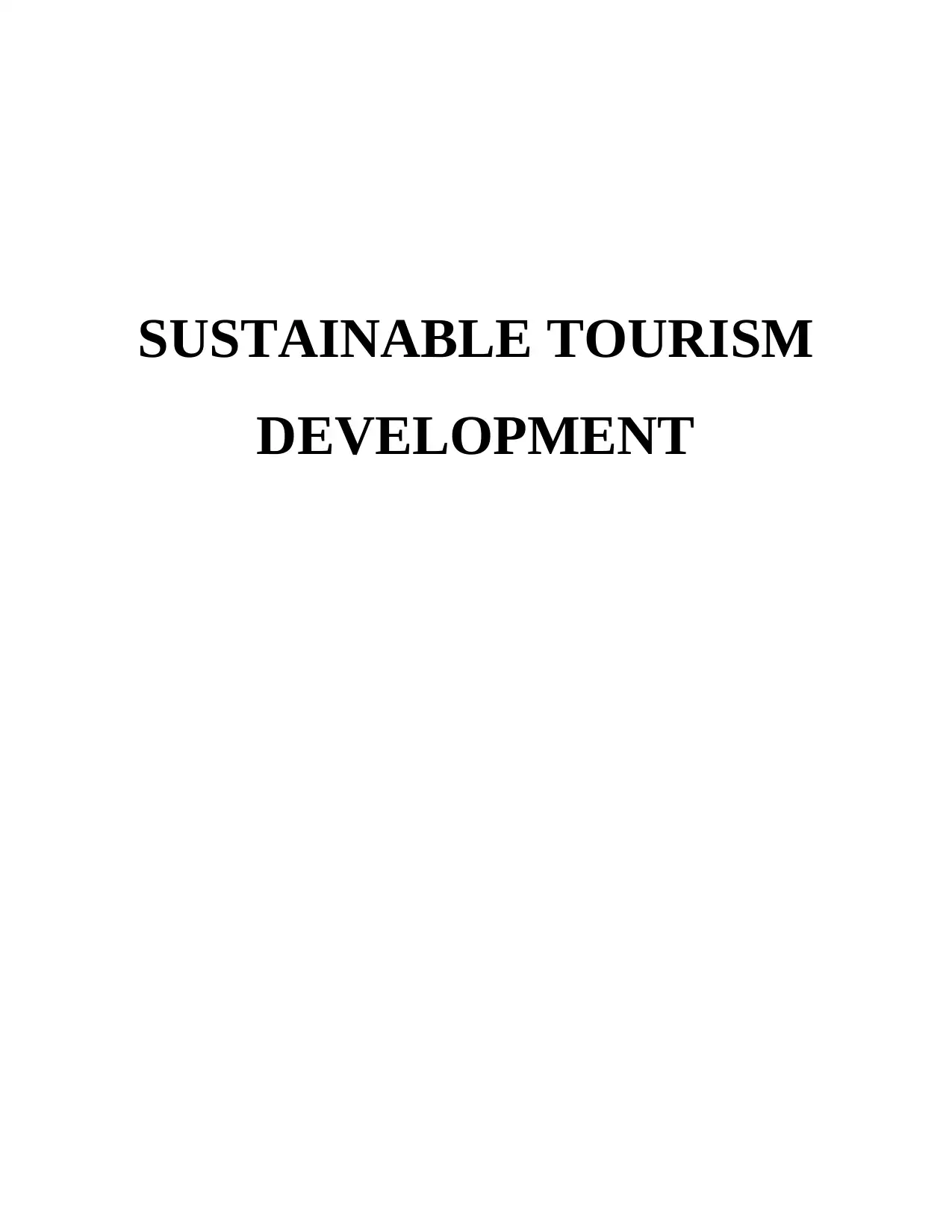
SUSTAINABLE TOURISM
DEVELOPMENT
DEVELOPMENT
Paraphrase This Document
Need a fresh take? Get an instant paraphrase of this document with our AI Paraphraser
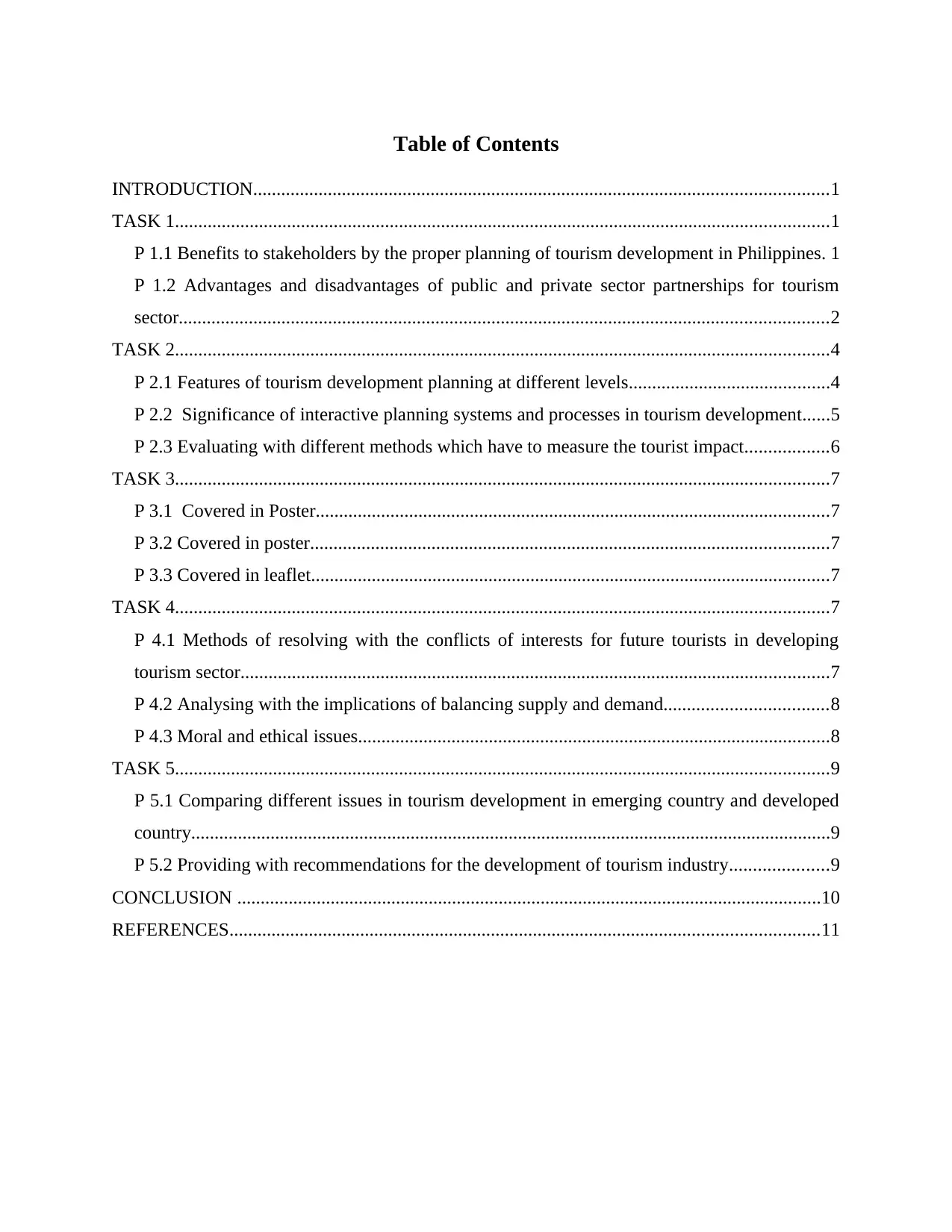
Table of Contents
INTRODUCTION...........................................................................................................................1
TASK 1............................................................................................................................................1
P 1.1 Benefits to stakeholders by the proper planning of tourism development in Philippines. 1
P 1.2 Advantages and disadvantages of public and private sector partnerships for tourism
sector...........................................................................................................................................2
TASK 2............................................................................................................................................4
P 2.1 Features of tourism development planning at different levels...........................................4
P 2.2 Significance of interactive planning systems and processes in tourism development......5
P 2.3 Evaluating with different methods which have to measure the tourist impact..................6
TASK 3............................................................................................................................................7
P 3.1 Covered in Poster..............................................................................................................7
P 3.2 Covered in poster...............................................................................................................7
P 3.3 Covered in leaflet...............................................................................................................7
TASK 4............................................................................................................................................7
P 4.1 Methods of resolving with the conflicts of interests for future tourists in developing
tourism sector..............................................................................................................................7
P 4.2 Analysing with the implications of balancing supply and demand...................................8
P 4.3 Moral and ethical issues.....................................................................................................8
TASK 5............................................................................................................................................9
P 5.1 Comparing different issues in tourism development in emerging country and developed
country.........................................................................................................................................9
P 5.2 Providing with recommendations for the development of tourism industry.....................9
CONCLUSION .............................................................................................................................10
REFERENCES..............................................................................................................................11
INTRODUCTION...........................................................................................................................1
TASK 1............................................................................................................................................1
P 1.1 Benefits to stakeholders by the proper planning of tourism development in Philippines. 1
P 1.2 Advantages and disadvantages of public and private sector partnerships for tourism
sector...........................................................................................................................................2
TASK 2............................................................................................................................................4
P 2.1 Features of tourism development planning at different levels...........................................4
P 2.2 Significance of interactive planning systems and processes in tourism development......5
P 2.3 Evaluating with different methods which have to measure the tourist impact..................6
TASK 3............................................................................................................................................7
P 3.1 Covered in Poster..............................................................................................................7
P 3.2 Covered in poster...............................................................................................................7
P 3.3 Covered in leaflet...............................................................................................................7
TASK 4............................................................................................................................................7
P 4.1 Methods of resolving with the conflicts of interests for future tourists in developing
tourism sector..............................................................................................................................7
P 4.2 Analysing with the implications of balancing supply and demand...................................8
P 4.3 Moral and ethical issues.....................................................................................................8
TASK 5............................................................................................................................................9
P 5.1 Comparing different issues in tourism development in emerging country and developed
country.........................................................................................................................................9
P 5.2 Providing with recommendations for the development of tourism industry.....................9
CONCLUSION .............................................................................................................................10
REFERENCES..............................................................................................................................11
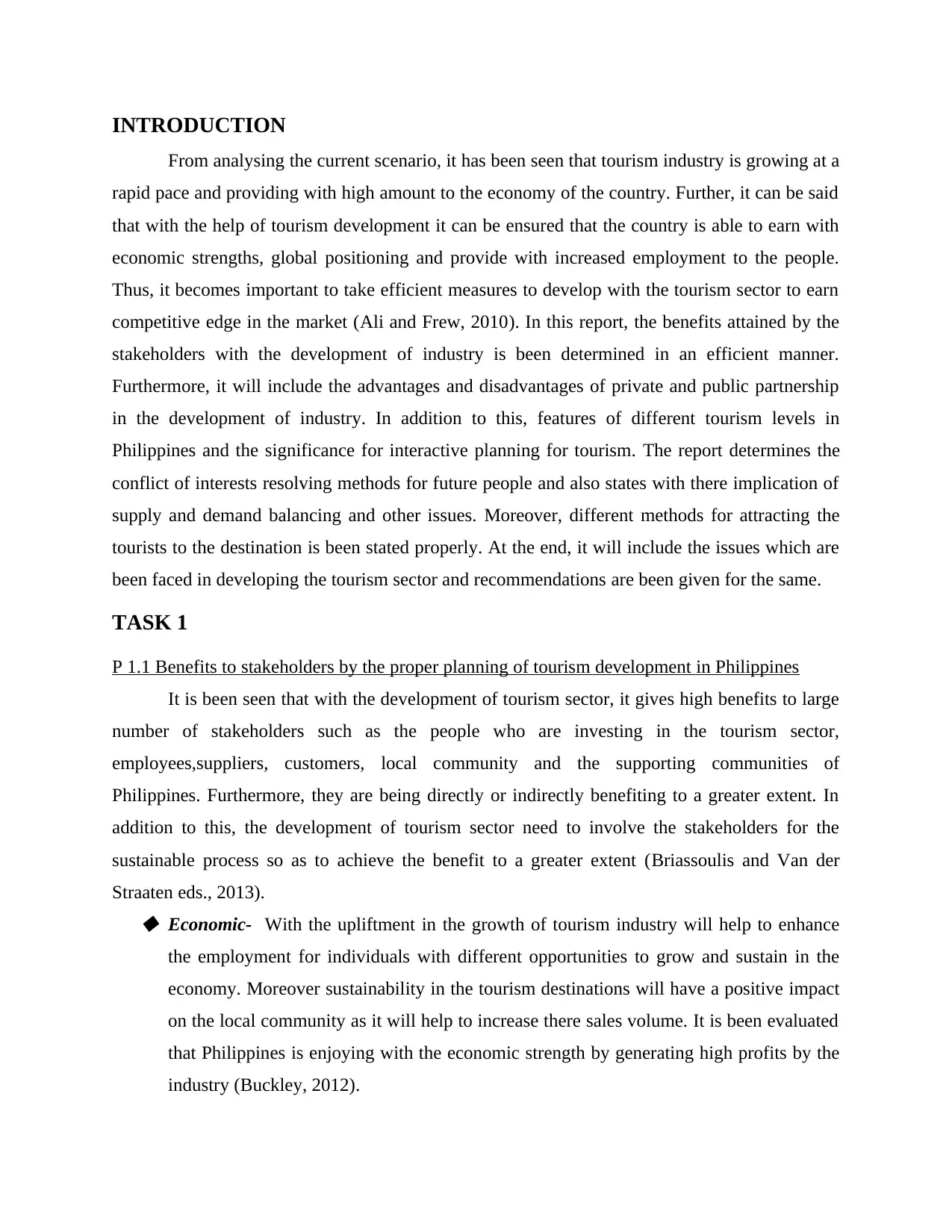
INTRODUCTION
From analysing the current scenario, it has been seen that tourism industry is growing at a
rapid pace and providing with high amount to the economy of the country. Further, it can be said
that with the help of tourism development it can be ensured that the country is able to earn with
economic strengths, global positioning and provide with increased employment to the people.
Thus, it becomes important to take efficient measures to develop with the tourism sector to earn
competitive edge in the market (Ali and Frew, 2010). In this report, the benefits attained by the
stakeholders with the development of industry is been determined in an efficient manner.
Furthermore, it will include the advantages and disadvantages of private and public partnership
in the development of industry. In addition to this, features of different tourism levels in
Philippines and the significance for interactive planning for tourism. The report determines the
conflict of interests resolving methods for future people and also states with there implication of
supply and demand balancing and other issues. Moreover, different methods for attracting the
tourists to the destination is been stated properly. At the end, it will include the issues which are
been faced in developing the tourism sector and recommendations are been given for the same.
TASK 1
P 1.1 Benefits to stakeholders by the proper planning of tourism development in Philippines
It is been seen that with the development of tourism sector, it gives high benefits to large
number of stakeholders such as the people who are investing in the tourism sector,
employees,suppliers, customers, local community and the supporting communities of
Philippines. Furthermore, they are being directly or indirectly benefiting to a greater extent. In
addition to this, the development of tourism sector need to involve the stakeholders for the
sustainable process so as to achieve the benefit to a greater extent (Briassoulis and Van der
Straaten eds., 2013). Economic- With the upliftment in the growth of tourism industry will help to enhance
the employment for individuals with different opportunities to grow and sustain in the
economy. Moreover sustainability in the tourism destinations will have a positive impact
on the local community as it will help to increase there sales volume. It is been evaluated
that Philippines is enjoying with the economic strength by generating high profits by the
industry (Buckley, 2012).
From analysing the current scenario, it has been seen that tourism industry is growing at a
rapid pace and providing with high amount to the economy of the country. Further, it can be said
that with the help of tourism development it can be ensured that the country is able to earn with
economic strengths, global positioning and provide with increased employment to the people.
Thus, it becomes important to take efficient measures to develop with the tourism sector to earn
competitive edge in the market (Ali and Frew, 2010). In this report, the benefits attained by the
stakeholders with the development of industry is been determined in an efficient manner.
Furthermore, it will include the advantages and disadvantages of private and public partnership
in the development of industry. In addition to this, features of different tourism levels in
Philippines and the significance for interactive planning for tourism. The report determines the
conflict of interests resolving methods for future people and also states with there implication of
supply and demand balancing and other issues. Moreover, different methods for attracting the
tourists to the destination is been stated properly. At the end, it will include the issues which are
been faced in developing the tourism sector and recommendations are been given for the same.
TASK 1
P 1.1 Benefits to stakeholders by the proper planning of tourism development in Philippines
It is been seen that with the development of tourism sector, it gives high benefits to large
number of stakeholders such as the people who are investing in the tourism sector,
employees,suppliers, customers, local community and the supporting communities of
Philippines. Furthermore, they are being directly or indirectly benefiting to a greater extent. In
addition to this, the development of tourism sector need to involve the stakeholders for the
sustainable process so as to achieve the benefit to a greater extent (Briassoulis and Van der
Straaten eds., 2013). Economic- With the upliftment in the growth of tourism industry will help to enhance
the employment for individuals with different opportunities to grow and sustain in the
economy. Moreover sustainability in the tourism destinations will have a positive impact
on the local community as it will help to increase there sales volume. It is been evaluated
that Philippines is enjoying with the economic strength by generating high profits by the
industry (Buckley, 2012).
⊘ This is a preview!⊘
Do you want full access?
Subscribe today to unlock all pages.

Trusted by 1+ million students worldwide
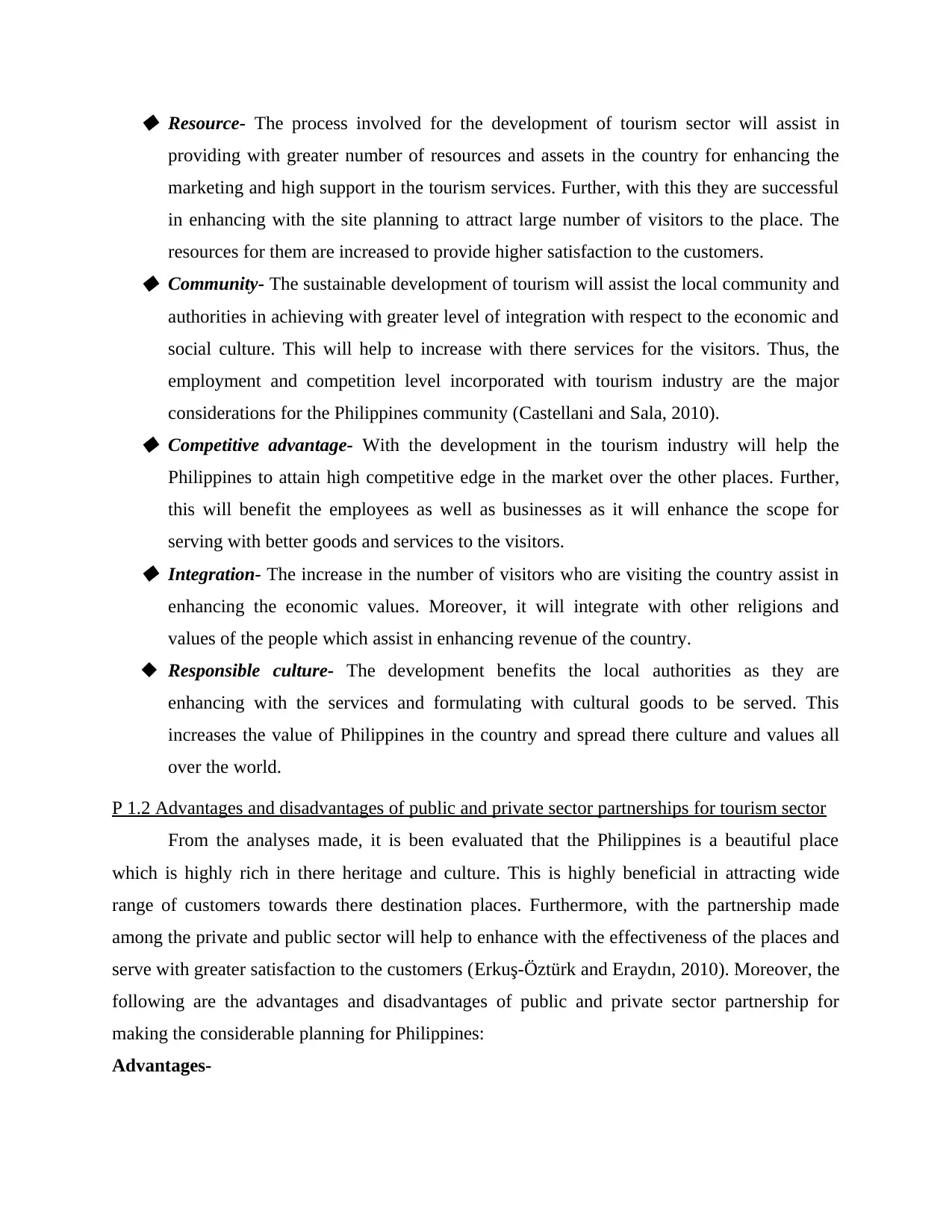
Resource- The process involved for the development of tourism sector will assist in
providing with greater number of resources and assets in the country for enhancing the
marketing and high support in the tourism services. Further, with this they are successful
in enhancing with the site planning to attract large number of visitors to the place. The
resources for them are increased to provide higher satisfaction to the customers. Community- The sustainable development of tourism will assist the local community and
authorities in achieving with greater level of integration with respect to the economic and
social culture. This will help to increase with there services for the visitors. Thus, the
employment and competition level incorporated with tourism industry are the major
considerations for the Philippines community (Castellani and Sala, 2010). Competitive advantage- With the development in the tourism industry will help the
Philippines to attain high competitive edge in the market over the other places. Further,
this will benefit the employees as well as businesses as it will enhance the scope for
serving with better goods and services to the visitors. Integration- The increase in the number of visitors who are visiting the country assist in
enhancing the economic values. Moreover, it will integrate with other religions and
values of the people which assist in enhancing revenue of the country.
Responsible culture- The development benefits the local authorities as they are
enhancing with the services and formulating with cultural goods to be served. This
increases the value of Philippines in the country and spread there culture and values all
over the world.
P 1.2 Advantages and disadvantages of public and private sector partnerships for tourism sector
From the analyses made, it is been evaluated that the Philippines is a beautiful place
which is highly rich in there heritage and culture. This is highly beneficial in attracting wide
range of customers towards there destination places. Furthermore, with the partnership made
among the private and public sector will help to enhance with the effectiveness of the places and
serve with greater satisfaction to the customers (Erkuş-Öztürk and Eraydın, 2010). Moreover, the
following are the advantages and disadvantages of public and private sector partnership for
making the considerable planning for Philippines:
Advantages-
providing with greater number of resources and assets in the country for enhancing the
marketing and high support in the tourism services. Further, with this they are successful
in enhancing with the site planning to attract large number of visitors to the place. The
resources for them are increased to provide higher satisfaction to the customers. Community- The sustainable development of tourism will assist the local community and
authorities in achieving with greater level of integration with respect to the economic and
social culture. This will help to increase with there services for the visitors. Thus, the
employment and competition level incorporated with tourism industry are the major
considerations for the Philippines community (Castellani and Sala, 2010). Competitive advantage- With the development in the tourism industry will help the
Philippines to attain high competitive edge in the market over the other places. Further,
this will benefit the employees as well as businesses as it will enhance the scope for
serving with better goods and services to the visitors. Integration- The increase in the number of visitors who are visiting the country assist in
enhancing the economic values. Moreover, it will integrate with other religions and
values of the people which assist in enhancing revenue of the country.
Responsible culture- The development benefits the local authorities as they are
enhancing with the services and formulating with cultural goods to be served. This
increases the value of Philippines in the country and spread there culture and values all
over the world.
P 1.2 Advantages and disadvantages of public and private sector partnerships for tourism sector
From the analyses made, it is been evaluated that the Philippines is a beautiful place
which is highly rich in there heritage and culture. This is highly beneficial in attracting wide
range of customers towards there destination places. Furthermore, with the partnership made
among the private and public sector will help to enhance with the effectiveness of the places and
serve with greater satisfaction to the customers (Erkuş-Öztürk and Eraydın, 2010). Moreover, the
following are the advantages and disadvantages of public and private sector partnership for
making the considerable planning for Philippines:
Advantages-
Paraphrase This Document
Need a fresh take? Get an instant paraphrase of this document with our AI Paraphraser
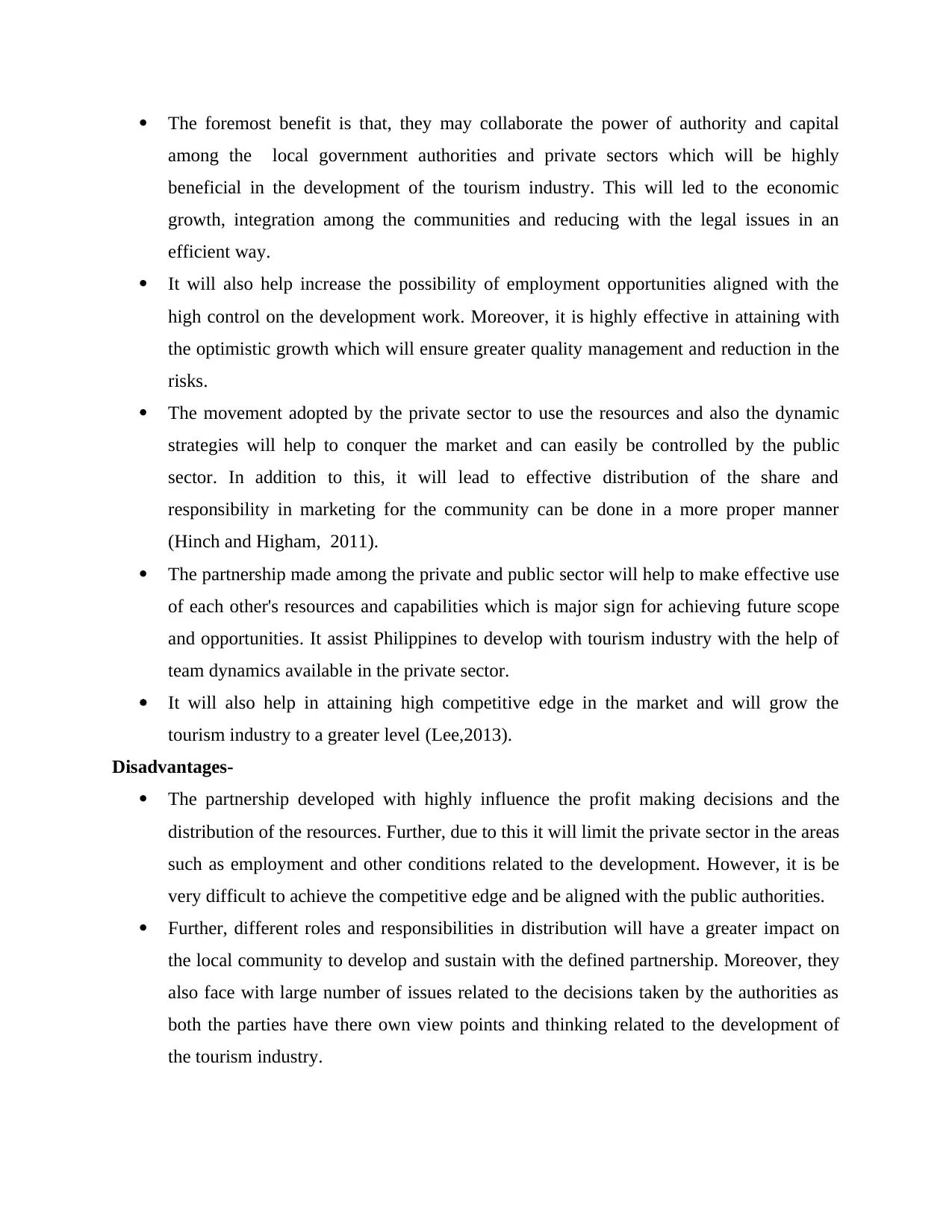
The foremost benefit is that, they may collaborate the power of authority and capital
among the local government authorities and private sectors which will be highly
beneficial in the development of the tourism industry. This will led to the economic
growth, integration among the communities and reducing with the legal issues in an
efficient way.
It will also help increase the possibility of employment opportunities aligned with the
high control on the development work. Moreover, it is highly effective in attaining with
the optimistic growth which will ensure greater quality management and reduction in the
risks.
The movement adopted by the private sector to use the resources and also the dynamic
strategies will help to conquer the market and can easily be controlled by the public
sector. In addition to this, it will lead to effective distribution of the share and
responsibility in marketing for the community can be done in a more proper manner
(Hinch and Higham, 2011).
The partnership made among the private and public sector will help to make effective use
of each other's resources and capabilities which is major sign for achieving future scope
and opportunities. It assist Philippines to develop with tourism industry with the help of
team dynamics available in the private sector.
It will also help in attaining high competitive edge in the market and will grow the
tourism industry to a greater level (Lee,2013).
Disadvantages-
The partnership developed with highly influence the profit making decisions and the
distribution of the resources. Further, due to this it will limit the private sector in the areas
such as employment and other conditions related to the development. However, it is be
very difficult to achieve the competitive edge and be aligned with the public authorities.
Further, different roles and responsibilities in distribution will have a greater impact on
the local community to develop and sustain with the defined partnership. Moreover, they
also face with large number of issues related to the decisions taken by the authorities as
both the parties have there own view points and thinking related to the development of
the tourism industry.
among the local government authorities and private sectors which will be highly
beneficial in the development of the tourism industry. This will led to the economic
growth, integration among the communities and reducing with the legal issues in an
efficient way.
It will also help increase the possibility of employment opportunities aligned with the
high control on the development work. Moreover, it is highly effective in attaining with
the optimistic growth which will ensure greater quality management and reduction in the
risks.
The movement adopted by the private sector to use the resources and also the dynamic
strategies will help to conquer the market and can easily be controlled by the public
sector. In addition to this, it will lead to effective distribution of the share and
responsibility in marketing for the community can be done in a more proper manner
(Hinch and Higham, 2011).
The partnership made among the private and public sector will help to make effective use
of each other's resources and capabilities which is major sign for achieving future scope
and opportunities. It assist Philippines to develop with tourism industry with the help of
team dynamics available in the private sector.
It will also help in attaining high competitive edge in the market and will grow the
tourism industry to a greater level (Lee,2013).
Disadvantages-
The partnership developed with highly influence the profit making decisions and the
distribution of the resources. Further, due to this it will limit the private sector in the areas
such as employment and other conditions related to the development. However, it is be
very difficult to achieve the competitive edge and be aligned with the public authorities.
Further, different roles and responsibilities in distribution will have a greater impact on
the local community to develop and sustain with the defined partnership. Moreover, they
also face with large number of issues related to the decisions taken by the authorities as
both the parties have there own view points and thinking related to the development of
the tourism industry.
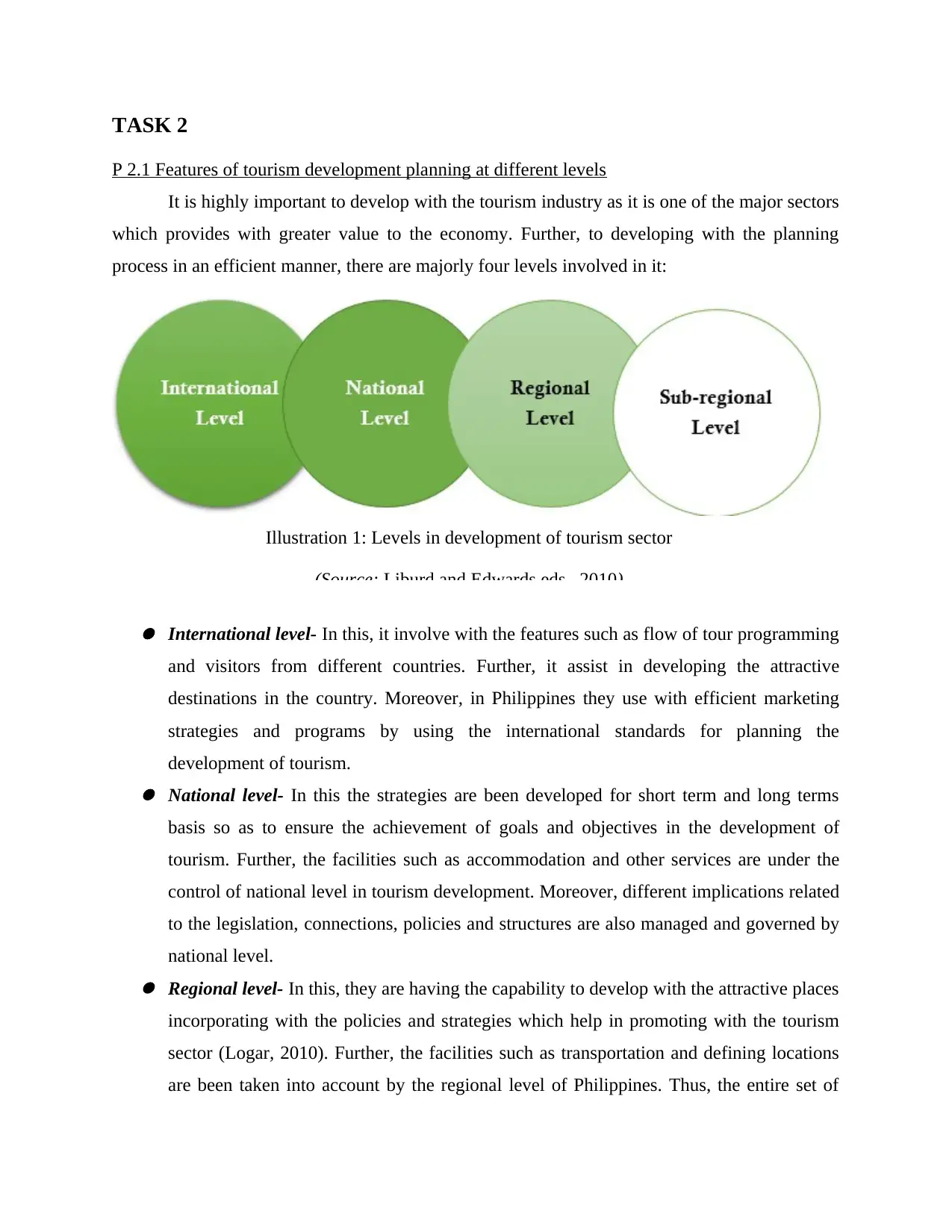
TASK 2
P 2.1 Features of tourism development planning at different levels
It is highly important to develop with the tourism industry as it is one of the major sectors
which provides with greater value to the economy. Further, to developing with the planning
process in an efficient manner, there are majorly four levels involved in it:
Illustration 1: Levels in development of tourism sector
(Source: Liburd and Edwards eds., 2010)
International level- In this, it involve with the features such as flow of tour programming
and visitors from different countries. Further, it assist in developing the attractive
destinations in the country. Moreover, in Philippines they use with efficient marketing
strategies and programs by using the international standards for planning the
development of tourism. National level- In this the strategies are been developed for short term and long terms
basis so as to ensure the achievement of goals and objectives in the development of
tourism. Further, the facilities such as accommodation and other services are under the
control of national level in tourism development. Moreover, different implications related
to the legislation, connections, policies and structures are also managed and governed by
national level. Regional level- In this, they are having the capability to develop with the attractive places
incorporating with the policies and strategies which help in promoting with the tourism
sector (Logar, 2010). Further, the facilities such as transportation and defining locations
are been taken into account by the regional level of Philippines. Thus, the entire set of
P 2.1 Features of tourism development planning at different levels
It is highly important to develop with the tourism industry as it is one of the major sectors
which provides with greater value to the economy. Further, to developing with the planning
process in an efficient manner, there are majorly four levels involved in it:
Illustration 1: Levels in development of tourism sector
(Source: Liburd and Edwards eds., 2010)
International level- In this, it involve with the features such as flow of tour programming
and visitors from different countries. Further, it assist in developing the attractive
destinations in the country. Moreover, in Philippines they use with efficient marketing
strategies and programs by using the international standards for planning the
development of tourism. National level- In this the strategies are been developed for short term and long terms
basis so as to ensure the achievement of goals and objectives in the development of
tourism. Further, the facilities such as accommodation and other services are under the
control of national level in tourism development. Moreover, different implications related
to the legislation, connections, policies and structures are also managed and governed by
national level. Regional level- In this, they are having the capability to develop with the attractive places
incorporating with the policies and strategies which help in promoting with the tourism
sector (Logar, 2010). Further, the facilities such as transportation and defining locations
are been taken into account by the regional level of Philippines. Thus, the entire set of
⊘ This is a preview!⊘
Do you want full access?
Subscribe today to unlock all pages.

Trusted by 1+ million students worldwide
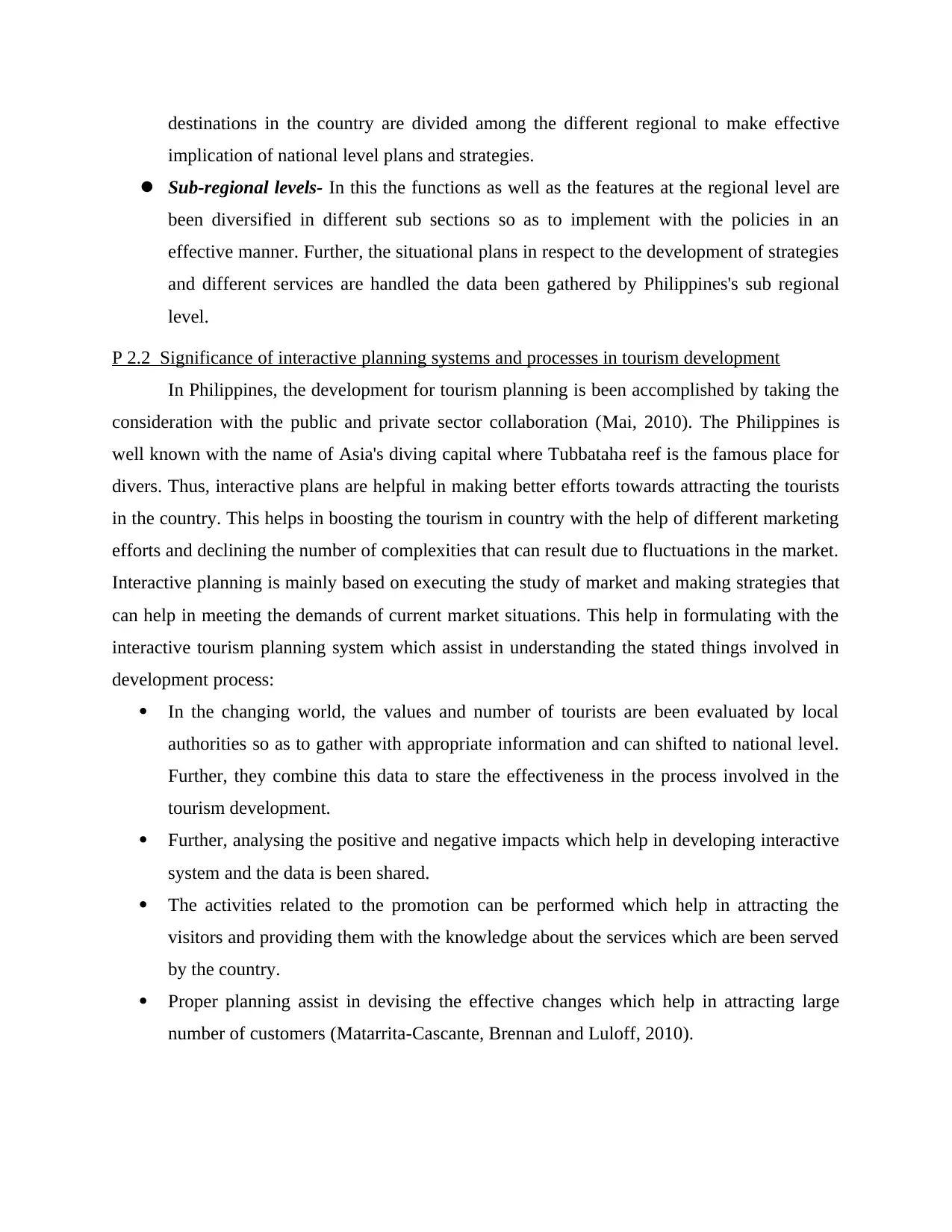
destinations in the country are divided among the different regional to make effective
implication of national level plans and strategies.
Sub-regional levels- In this the functions as well as the features at the regional level are
been diversified in different sub sections so as to implement with the policies in an
effective manner. Further, the situational plans in respect to the development of strategies
and different services are handled the data been gathered by Philippines's sub regional
level.
P 2.2 Significance of interactive planning systems and processes in tourism development
In Philippines, the development for tourism planning is been accomplished by taking the
consideration with the public and private sector collaboration (Mai, 2010). The Philippines is
well known with the name of Asia's diving capital where Tubbataha reef is the famous place for
divers. Thus, interactive plans are helpful in making better efforts towards attracting the tourists
in the country. This helps in boosting the tourism in country with the help of different marketing
efforts and declining the number of complexities that can result due to fluctuations in the market.
Interactive planning is mainly based on executing the study of market and making strategies that
can help in meeting the demands of current market situations. This help in formulating with the
interactive tourism planning system which assist in understanding the stated things involved in
development process:
In the changing world, the values and number of tourists are been evaluated by local
authorities so as to gather with appropriate information and can shifted to national level.
Further, they combine this data to stare the effectiveness in the process involved in the
tourism development.
Further, analysing the positive and negative impacts which help in developing interactive
system and the data is been shared.
The activities related to the promotion can be performed which help in attracting the
visitors and providing them with the knowledge about the services which are been served
by the country.
Proper planning assist in devising the effective changes which help in attracting large
number of customers (Matarrita-Cascante, Brennan and Luloff, 2010).
implication of national level plans and strategies.
Sub-regional levels- In this the functions as well as the features at the regional level are
been diversified in different sub sections so as to implement with the policies in an
effective manner. Further, the situational plans in respect to the development of strategies
and different services are handled the data been gathered by Philippines's sub regional
level.
P 2.2 Significance of interactive planning systems and processes in tourism development
In Philippines, the development for tourism planning is been accomplished by taking the
consideration with the public and private sector collaboration (Mai, 2010). The Philippines is
well known with the name of Asia's diving capital where Tubbataha reef is the famous place for
divers. Thus, interactive plans are helpful in making better efforts towards attracting the tourists
in the country. This helps in boosting the tourism in country with the help of different marketing
efforts and declining the number of complexities that can result due to fluctuations in the market.
Interactive planning is mainly based on executing the study of market and making strategies that
can help in meeting the demands of current market situations. This help in formulating with the
interactive tourism planning system which assist in understanding the stated things involved in
development process:
In the changing world, the values and number of tourists are been evaluated by local
authorities so as to gather with appropriate information and can shifted to national level.
Further, they combine this data to stare the effectiveness in the process involved in the
tourism development.
Further, analysing the positive and negative impacts which help in developing interactive
system and the data is been shared.
The activities related to the promotion can be performed which help in attracting the
visitors and providing them with the knowledge about the services which are been served
by the country.
Proper planning assist in devising the effective changes which help in attracting large
number of customers (Matarrita-Cascante, Brennan and Luloff, 2010).
Paraphrase This Document
Need a fresh take? Get an instant paraphrase of this document with our AI Paraphraser
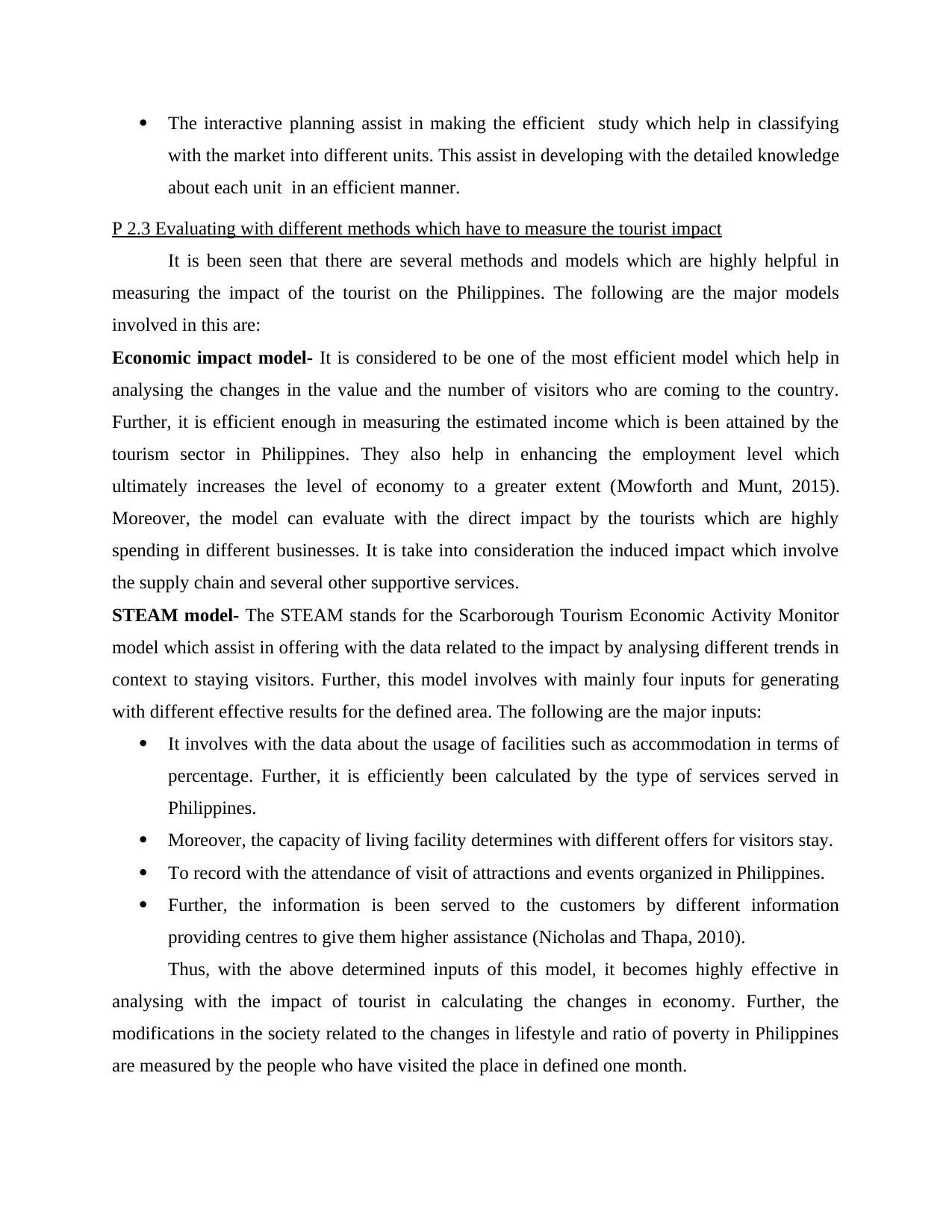
The interactive planning assist in making the efficient study which help in classifying
with the market into different units. This assist in developing with the detailed knowledge
about each unit in an efficient manner.
P 2.3 Evaluating with different methods which have to measure the tourist impact
It is been seen that there are several methods and models which are highly helpful in
measuring the impact of the tourist on the Philippines. The following are the major models
involved in this are:
Economic impact model- It is considered to be one of the most efficient model which help in
analysing the changes in the value and the number of visitors who are coming to the country.
Further, it is efficient enough in measuring the estimated income which is been attained by the
tourism sector in Philippines. They also help in enhancing the employment level which
ultimately increases the level of economy to a greater extent (Mowforth and Munt, 2015).
Moreover, the model can evaluate with the direct impact by the tourists which are highly
spending in different businesses. It is take into consideration the induced impact which involve
the supply chain and several other supportive services.
STEAM model- The STEAM stands for the Scarborough Tourism Economic Activity Monitor
model which assist in offering with the data related to the impact by analysing different trends in
context to staying visitors. Further, this model involves with mainly four inputs for generating
with different effective results for the defined area. The following are the major inputs:
It involves with the data about the usage of facilities such as accommodation in terms of
percentage. Further, it is efficiently been calculated by the type of services served in
Philippines.
Moreover, the capacity of living facility determines with different offers for visitors stay.
To record with the attendance of visit of attractions and events organized in Philippines.
Further, the information is been served to the customers by different information
providing centres to give them higher assistance (Nicholas and Thapa, 2010).
Thus, with the above determined inputs of this model, it becomes highly effective in
analysing with the impact of tourist in calculating the changes in economy. Further, the
modifications in the society related to the changes in lifestyle and ratio of poverty in Philippines
are measured by the people who have visited the place in defined one month.
with the market into different units. This assist in developing with the detailed knowledge
about each unit in an efficient manner.
P 2.3 Evaluating with different methods which have to measure the tourist impact
It is been seen that there are several methods and models which are highly helpful in
measuring the impact of the tourist on the Philippines. The following are the major models
involved in this are:
Economic impact model- It is considered to be one of the most efficient model which help in
analysing the changes in the value and the number of visitors who are coming to the country.
Further, it is efficient enough in measuring the estimated income which is been attained by the
tourism sector in Philippines. They also help in enhancing the employment level which
ultimately increases the level of economy to a greater extent (Mowforth and Munt, 2015).
Moreover, the model can evaluate with the direct impact by the tourists which are highly
spending in different businesses. It is take into consideration the induced impact which involve
the supply chain and several other supportive services.
STEAM model- The STEAM stands for the Scarborough Tourism Economic Activity Monitor
model which assist in offering with the data related to the impact by analysing different trends in
context to staying visitors. Further, this model involves with mainly four inputs for generating
with different effective results for the defined area. The following are the major inputs:
It involves with the data about the usage of facilities such as accommodation in terms of
percentage. Further, it is efficiently been calculated by the type of services served in
Philippines.
Moreover, the capacity of living facility determines with different offers for visitors stay.
To record with the attendance of visit of attractions and events organized in Philippines.
Further, the information is been served to the customers by different information
providing centres to give them higher assistance (Nicholas and Thapa, 2010).
Thus, with the above determined inputs of this model, it becomes highly effective in
analysing with the impact of tourist in calculating the changes in economy. Further, the
modifications in the society related to the changes in lifestyle and ratio of poverty in Philippines
are measured by the people who have visited the place in defined one month.
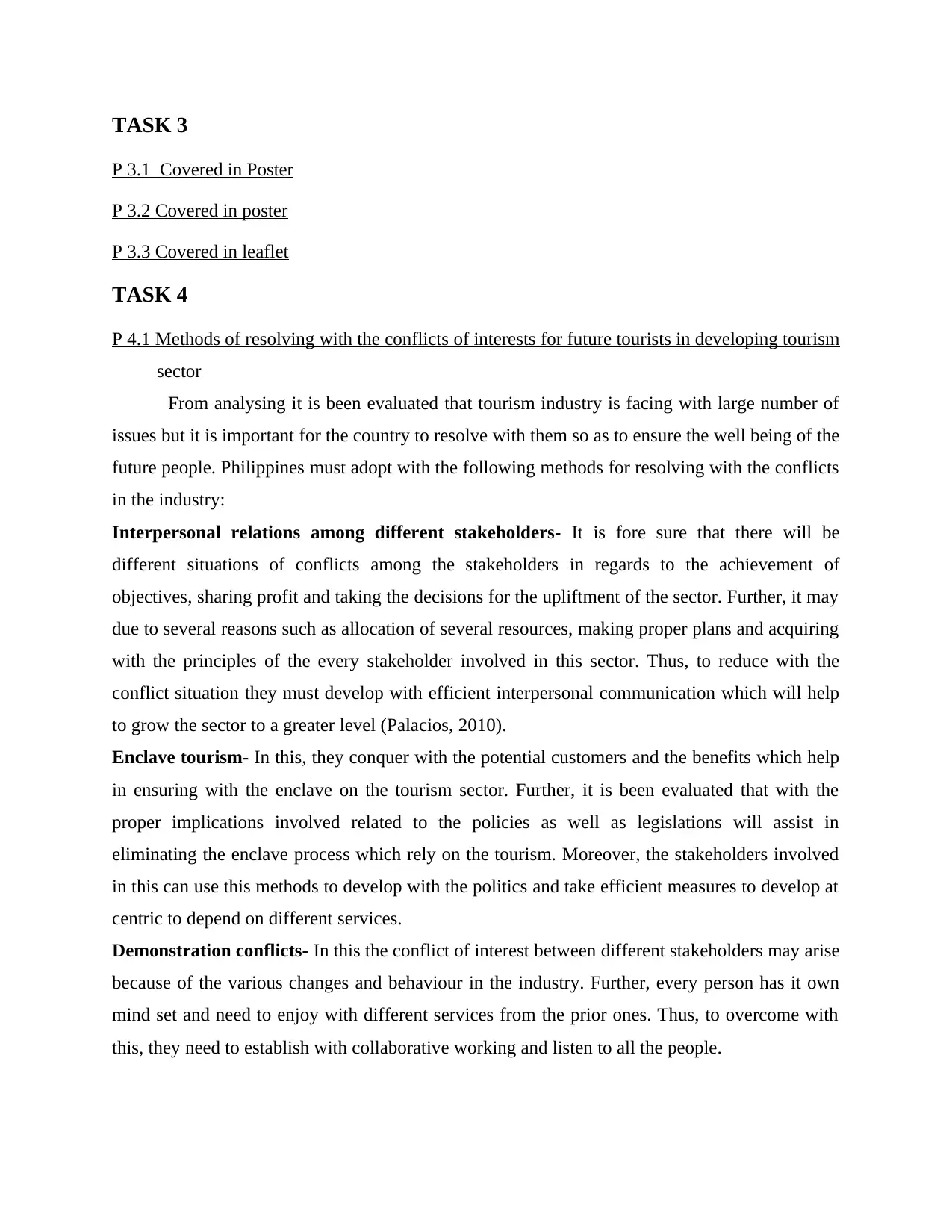
TASK 3
P 3.1 Covered in Poster
P 3.2 Covered in poster
P 3.3 Covered in leaflet
TASK 4
P 4.1 Methods of resolving with the conflicts of interests for future tourists in developing tourism
sector
From analysing it is been evaluated that tourism industry is facing with large number of
issues but it is important for the country to resolve with them so as to ensure the well being of the
future people. Philippines must adopt with the following methods for resolving with the conflicts
in the industry:
Interpersonal relations among different stakeholders- It is fore sure that there will be
different situations of conflicts among the stakeholders in regards to the achievement of
objectives, sharing profit and taking the decisions for the upliftment of the sector. Further, it may
due to several reasons such as allocation of several resources, making proper plans and acquiring
with the principles of the every stakeholder involved in this sector. Thus, to reduce with the
conflict situation they must develop with efficient interpersonal communication which will help
to grow the sector to a greater level (Palacios, 2010).
Enclave tourism- In this, they conquer with the potential customers and the benefits which help
in ensuring with the enclave on the tourism sector. Further, it is been evaluated that with the
proper implications involved related to the policies as well as legislations will assist in
eliminating the enclave process which rely on the tourism. Moreover, the stakeholders involved
in this can use this methods to develop with the politics and take efficient measures to develop at
centric to depend on different services.
Demonstration conflicts- In this the conflict of interest between different stakeholders may arise
because of the various changes and behaviour in the industry. Further, every person has it own
mind set and need to enjoy with different services from the prior ones. Thus, to overcome with
this, they need to establish with collaborative working and listen to all the people.
P 3.1 Covered in Poster
P 3.2 Covered in poster
P 3.3 Covered in leaflet
TASK 4
P 4.1 Methods of resolving with the conflicts of interests for future tourists in developing tourism
sector
From analysing it is been evaluated that tourism industry is facing with large number of
issues but it is important for the country to resolve with them so as to ensure the well being of the
future people. Philippines must adopt with the following methods for resolving with the conflicts
in the industry:
Interpersonal relations among different stakeholders- It is fore sure that there will be
different situations of conflicts among the stakeholders in regards to the achievement of
objectives, sharing profit and taking the decisions for the upliftment of the sector. Further, it may
due to several reasons such as allocation of several resources, making proper plans and acquiring
with the principles of the every stakeholder involved in this sector. Thus, to reduce with the
conflict situation they must develop with efficient interpersonal communication which will help
to grow the sector to a greater level (Palacios, 2010).
Enclave tourism- In this, they conquer with the potential customers and the benefits which help
in ensuring with the enclave on the tourism sector. Further, it is been evaluated that with the
proper implications involved related to the policies as well as legislations will assist in
eliminating the enclave process which rely on the tourism. Moreover, the stakeholders involved
in this can use this methods to develop with the politics and take efficient measures to develop at
centric to depend on different services.
Demonstration conflicts- In this the conflict of interest between different stakeholders may arise
because of the various changes and behaviour in the industry. Further, every person has it own
mind set and need to enjoy with different services from the prior ones. Thus, to overcome with
this, they need to establish with collaborative working and listen to all the people.
⊘ This is a preview!⊘
Do you want full access?
Subscribe today to unlock all pages.

Trusted by 1+ million students worldwide
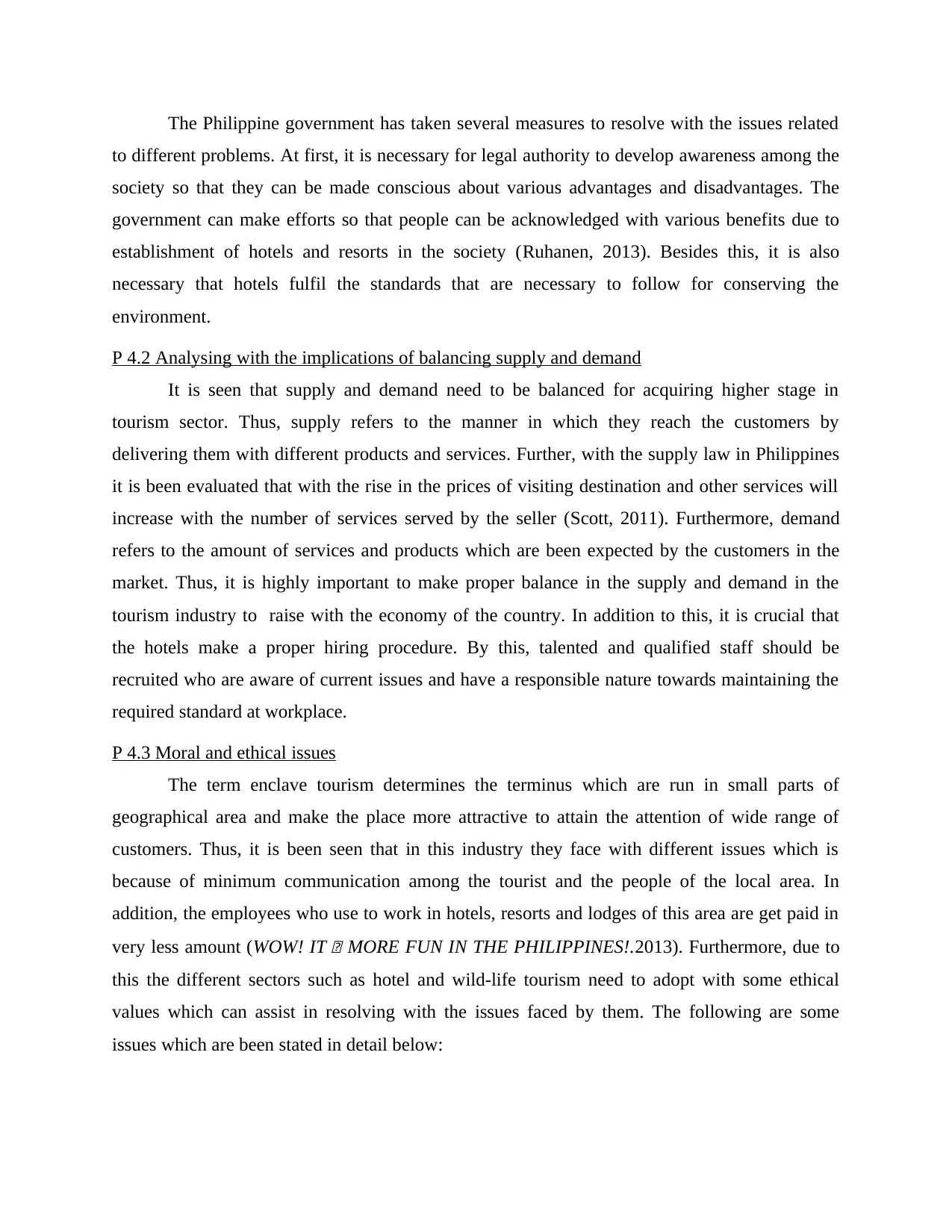
The Philippine government has taken several measures to resolve with the issues related
to different problems. At first, it is necessary for legal authority to develop awareness among the
society so that they can be made conscious about various advantages and disadvantages. The
government can make efforts so that people can be acknowledged with various benefits due to
establishment of hotels and resorts in the society (Ruhanen, 2013). Besides this, it is also
necessary that hotels fulfil the standards that are necessary to follow for conserving the
environment.
P 4.2 Analysing with the implications of balancing supply and demand
It is seen that supply and demand need to be balanced for acquiring higher stage in
tourism sector. Thus, supply refers to the manner in which they reach the customers by
delivering them with different products and services. Further, with the supply law in Philippines
it is been evaluated that with the rise in the prices of visiting destination and other services will
increase with the number of services served by the seller (Scott, 2011). Furthermore, demand
refers to the amount of services and products which are been expected by the customers in the
market. Thus, it is highly important to make proper balance in the supply and demand in the
tourism industry to raise with the economy of the country. In addition to this, it is crucial that
the hotels make a proper hiring procedure. By this, talented and qualified staff should be
recruited who are aware of current issues and have a responsible nature towards maintaining the
required standard at workplace.
P 4.3 Moral and ethical issues
The term enclave tourism determines the terminus which are run in small parts of
geographical area and make the place more attractive to attain the attention of wide range of
customers. Thus, it is been seen that in this industry they face with different issues which is
because of minimum communication among the tourist and the people of the local area. In
addition, the employees who use to work in hotels, resorts and lodges of this area are get paid in
very less amount (WOW! IT
担 MORE FUN IN THE PHILIPPINES!.2013). Furthermore, due to
this the different sectors such as hotel and wild-life tourism need to adopt with some ethical
values which can assist in resolving with the issues faced by them. The following are some
issues which are been stated in detail below:
to different problems. At first, it is necessary for legal authority to develop awareness among the
society so that they can be made conscious about various advantages and disadvantages. The
government can make efforts so that people can be acknowledged with various benefits due to
establishment of hotels and resorts in the society (Ruhanen, 2013). Besides this, it is also
necessary that hotels fulfil the standards that are necessary to follow for conserving the
environment.
P 4.2 Analysing with the implications of balancing supply and demand
It is seen that supply and demand need to be balanced for acquiring higher stage in
tourism sector. Thus, supply refers to the manner in which they reach the customers by
delivering them with different products and services. Further, with the supply law in Philippines
it is been evaluated that with the rise in the prices of visiting destination and other services will
increase with the number of services served by the seller (Scott, 2011). Furthermore, demand
refers to the amount of services and products which are been expected by the customers in the
market. Thus, it is highly important to make proper balance in the supply and demand in the
tourism industry to raise with the economy of the country. In addition to this, it is crucial that
the hotels make a proper hiring procedure. By this, talented and qualified staff should be
recruited who are aware of current issues and have a responsible nature towards maintaining the
required standard at workplace.
P 4.3 Moral and ethical issues
The term enclave tourism determines the terminus which are run in small parts of
geographical area and make the place more attractive to attain the attention of wide range of
customers. Thus, it is been seen that in this industry they face with different issues which is
because of minimum communication among the tourist and the people of the local area. In
addition, the employees who use to work in hotels, resorts and lodges of this area are get paid in
very less amount (WOW! IT
担 MORE FUN IN THE PHILIPPINES!.2013). Furthermore, due to
this the different sectors such as hotel and wild-life tourism need to adopt with some ethical
values which can assist in resolving with the issues faced by them. The following are some
issues which are been stated in detail below:
Paraphrase This Document
Need a fresh take? Get an instant paraphrase of this document with our AI Paraphraser
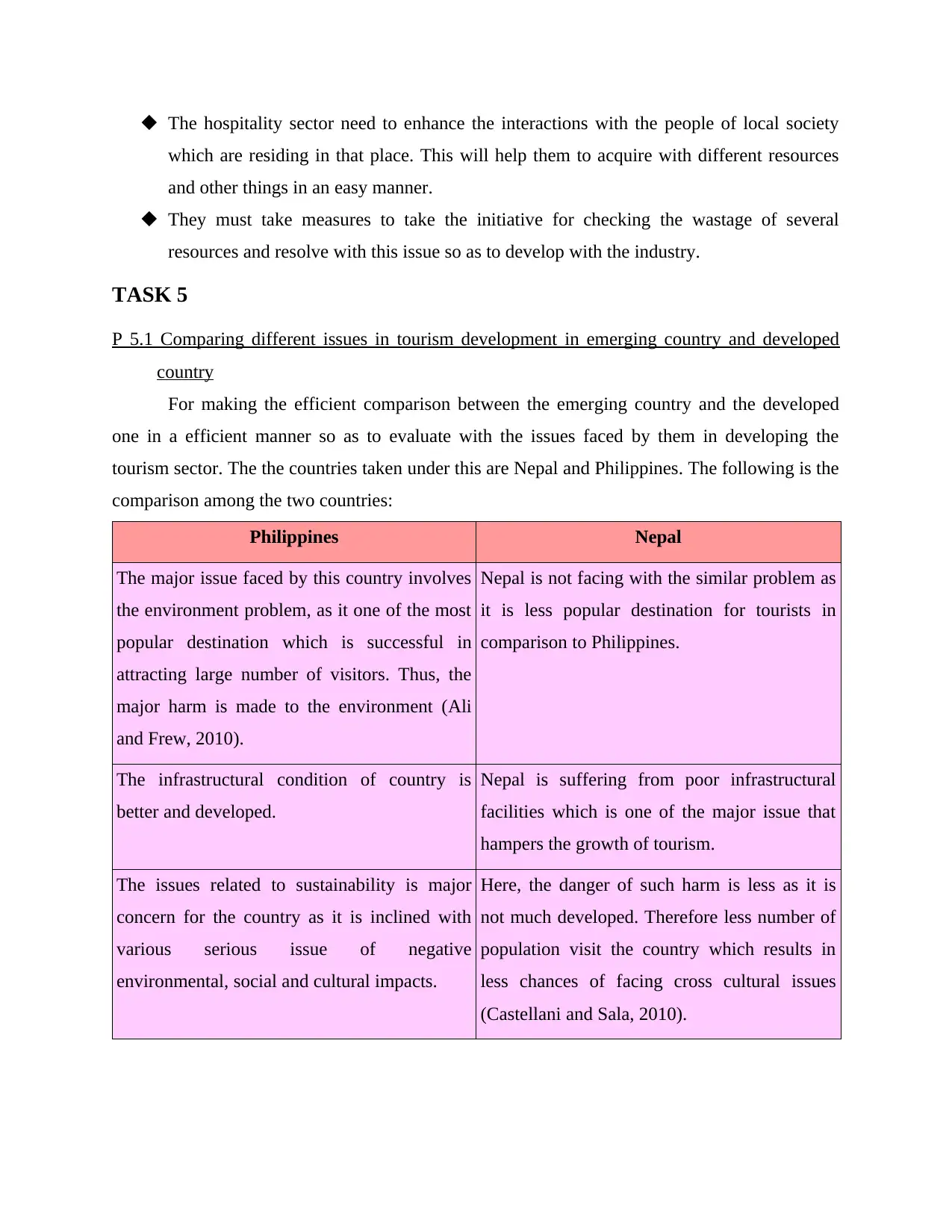
The hospitality sector need to enhance the interactions with the people of local society
which are residing in that place. This will help them to acquire with different resources
and other things in an easy manner.
They must take measures to take the initiative for checking the wastage of several
resources and resolve with this issue so as to develop with the industry.
TASK 5
P 5.1 Comparing different issues in tourism development in emerging country and developed
country
For making the efficient comparison between the emerging country and the developed
one in a efficient manner so as to evaluate with the issues faced by them in developing the
tourism sector. The the countries taken under this are Nepal and Philippines. The following is the
comparison among the two countries:
Philippines Nepal
The major issue faced by this country involves
the environment problem, as it one of the most
popular destination which is successful in
attracting large number of visitors. Thus, the
major harm is made to the environment (Ali
and Frew, 2010).
Nepal is not facing with the similar problem as
it is less popular destination for tourists in
comparison to Philippines.
The infrastructural condition of country is
better and developed.
Nepal is suffering from poor infrastructural
facilities which is one of the major issue that
hampers the growth of tourism.
The issues related to sustainability is major
concern for the country as it is inclined with
various serious issue of negative
environmental, social and cultural impacts.
Here, the danger of such harm is less as it is
not much developed. Therefore less number of
population visit the country which results in
less chances of facing cross cultural issues
(Castellani and Sala, 2010).
which are residing in that place. This will help them to acquire with different resources
and other things in an easy manner.
They must take measures to take the initiative for checking the wastage of several
resources and resolve with this issue so as to develop with the industry.
TASK 5
P 5.1 Comparing different issues in tourism development in emerging country and developed
country
For making the efficient comparison between the emerging country and the developed
one in a efficient manner so as to evaluate with the issues faced by them in developing the
tourism sector. The the countries taken under this are Nepal and Philippines. The following is the
comparison among the two countries:
Philippines Nepal
The major issue faced by this country involves
the environment problem, as it one of the most
popular destination which is successful in
attracting large number of visitors. Thus, the
major harm is made to the environment (Ali
and Frew, 2010).
Nepal is not facing with the similar problem as
it is less popular destination for tourists in
comparison to Philippines.
The infrastructural condition of country is
better and developed.
Nepal is suffering from poor infrastructural
facilities which is one of the major issue that
hampers the growth of tourism.
The issues related to sustainability is major
concern for the country as it is inclined with
various serious issue of negative
environmental, social and cultural impacts.
Here, the danger of such harm is less as it is
not much developed. Therefore less number of
population visit the country which results in
less chances of facing cross cultural issues
(Castellani and Sala, 2010).
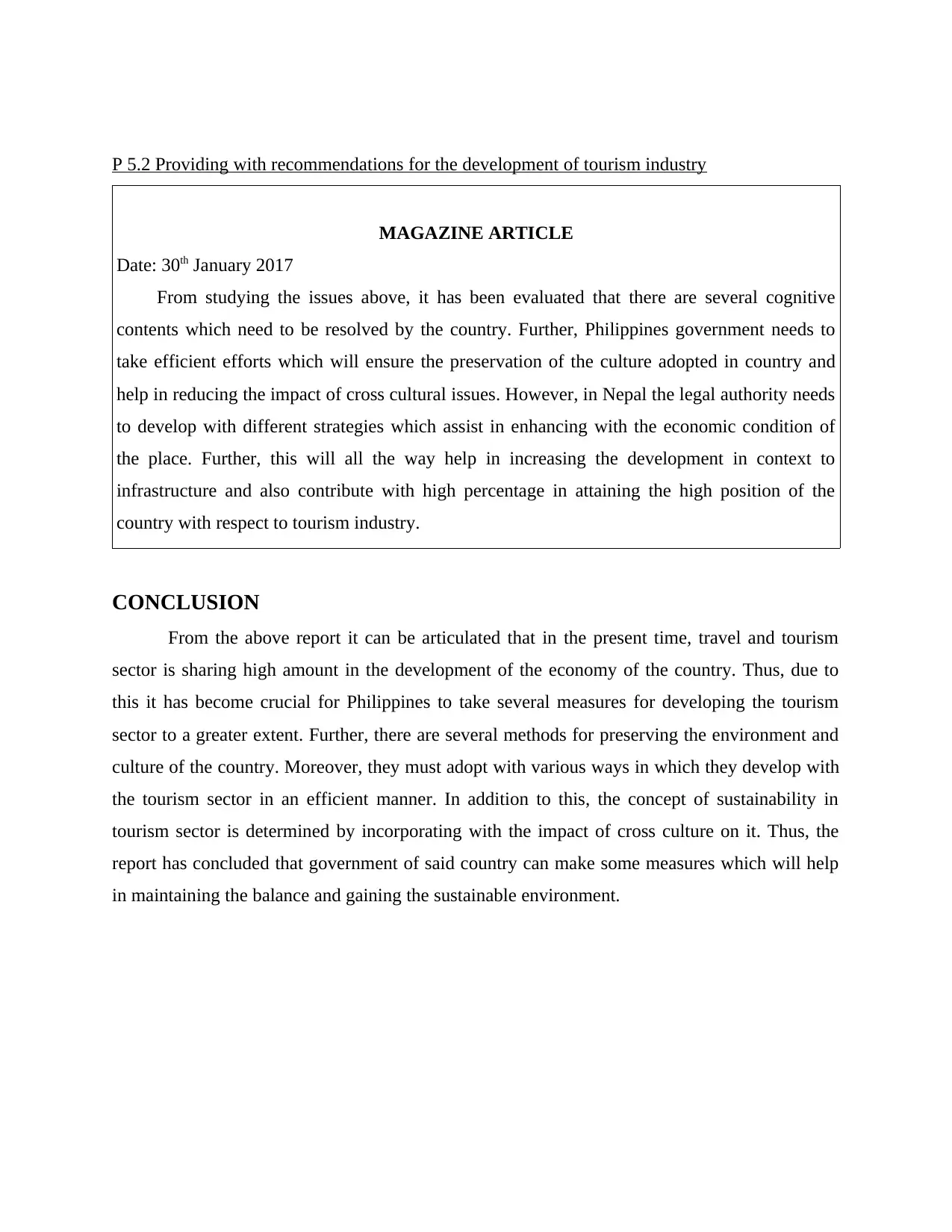
P 5.2 Providing with recommendations for the development of tourism industry
MAGAZINE ARTICLE
Date: 30th January 2017
From studying the issues above, it has been evaluated that there are several cognitive
contents which need to be resolved by the country. Further, Philippines government needs to
take efficient efforts which will ensure the preservation of the culture adopted in country and
help in reducing the impact of cross cultural issues. However, in Nepal the legal authority needs
to develop with different strategies which assist in enhancing with the economic condition of
the place. Further, this will all the way help in increasing the development in context to
infrastructure and also contribute with high percentage in attaining the high position of the
country with respect to tourism industry.
CONCLUSION
From the above report it can be articulated that in the present time, travel and tourism
sector is sharing high amount in the development of the economy of the country. Thus, due to
this it has become crucial for Philippines to take several measures for developing the tourism
sector to a greater extent. Further, there are several methods for preserving the environment and
culture of the country. Moreover, they must adopt with various ways in which they develop with
the tourism sector in an efficient manner. In addition to this, the concept of sustainability in
tourism sector is determined by incorporating with the impact of cross culture on it. Thus, the
report has concluded that government of said country can make some measures which will help
in maintaining the balance and gaining the sustainable environment.
MAGAZINE ARTICLE
Date: 30th January 2017
From studying the issues above, it has been evaluated that there are several cognitive
contents which need to be resolved by the country. Further, Philippines government needs to
take efficient efforts which will ensure the preservation of the culture adopted in country and
help in reducing the impact of cross cultural issues. However, in Nepal the legal authority needs
to develop with different strategies which assist in enhancing with the economic condition of
the place. Further, this will all the way help in increasing the development in context to
infrastructure and also contribute with high percentage in attaining the high position of the
country with respect to tourism industry.
CONCLUSION
From the above report it can be articulated that in the present time, travel and tourism
sector is sharing high amount in the development of the economy of the country. Thus, due to
this it has become crucial for Philippines to take several measures for developing the tourism
sector to a greater extent. Further, there are several methods for preserving the environment and
culture of the country. Moreover, they must adopt with various ways in which they develop with
the tourism sector in an efficient manner. In addition to this, the concept of sustainability in
tourism sector is determined by incorporating with the impact of cross culture on it. Thus, the
report has concluded that government of said country can make some measures which will help
in maintaining the balance and gaining the sustainable environment.
⊘ This is a preview!⊘
Do you want full access?
Subscribe today to unlock all pages.

Trusted by 1+ million students worldwide
1 out of 15
Related Documents
Your All-in-One AI-Powered Toolkit for Academic Success.
+13062052269
info@desklib.com
Available 24*7 on WhatsApp / Email
![[object Object]](/_next/static/media/star-bottom.7253800d.svg)
Unlock your academic potential
Copyright © 2020–2025 A2Z Services. All Rights Reserved. Developed and managed by ZUCOL.





